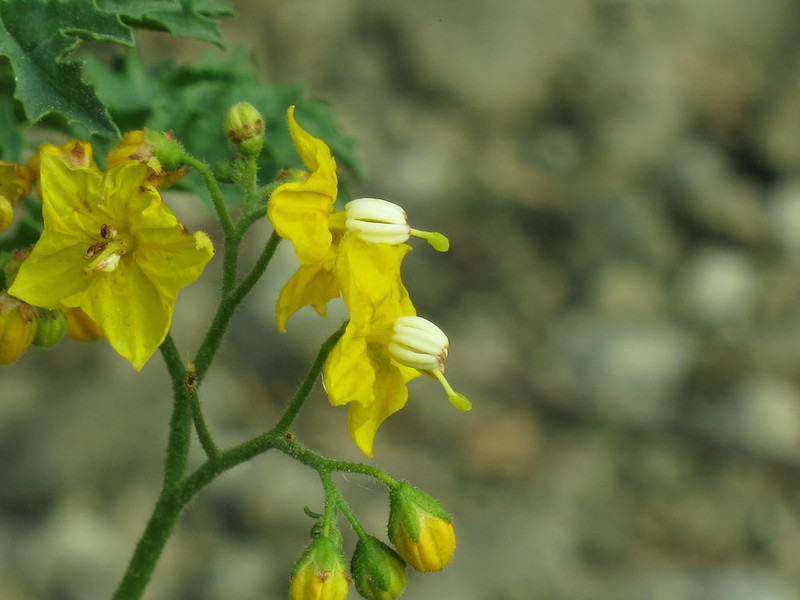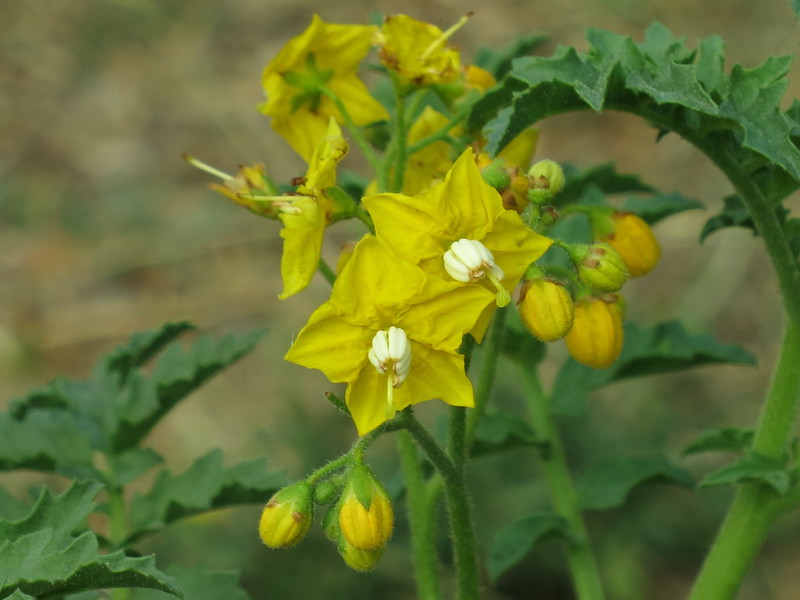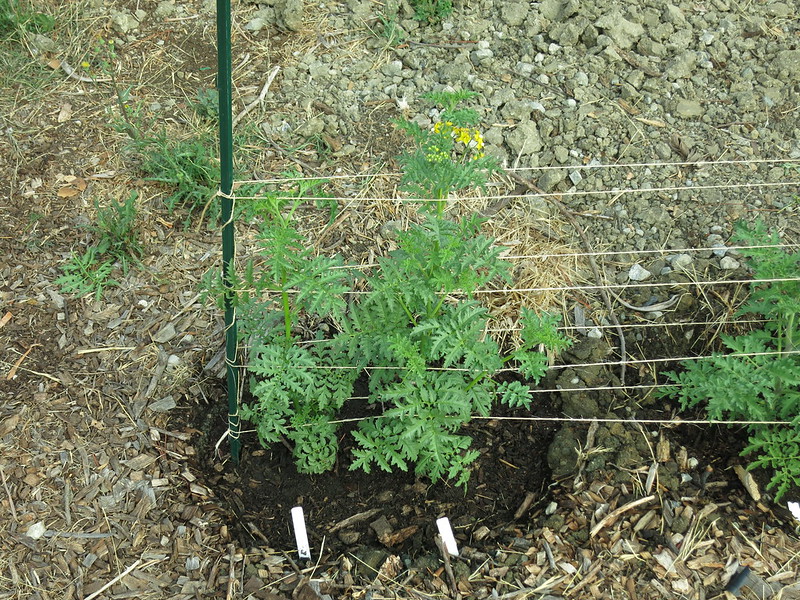|
|
Post by keen101 (Biolumo / Andrew B.) on Feb 22, 2018 14:36:09 GMT -5
okay, heading into unknown and difficult waters. Attempted to plant seeds for one accession of S. sitiens and one accession of S. lycopersicoides today. Both are probably difficult to cross into domestic tomatoes because of a common inversion on chromosome 11 i think. I guess that inversion is common to the potato genome which is interesting. wonder if these could cross with diploid potatoes better.
But potential for useful traits is high in these species. May need to use chilense or pennellii as bridge species. Frost tolerance may be high, as well as unusual scented flowers.
S. sitiens should flower all year but has smelly flowers to attract flies and maybe beetles.
S. lycopersicoides may only flower spring and fall. But have sweet smelling flowers reportedly.
Curious to know what a cross between each other would accomplish in this regard for flower scent. Maybe crossing them first would help to then cross into other interspecies hybrids in order to move these traits closer to domestic tomatoes.
|
|
|
|
Post by templeton on Feb 22, 2018 16:50:51 GMT -5
Do I properly recall that grafting can sometimes help pollen acceptance? Not sure if this would help.
|
|
|
|
Post by keen101 (Biolumo / Andrew B.) on Feb 22, 2018 23:27:28 GMT -5
Do I properly recall that grafting can sometimes help pollen acceptance? Not sure if this would help. Maybe, are you referring to Michurin teqnique? If so, that is the only thing i can think of. Perhaps grafting onto the intended species could help reduce rejection, especially if the reciprocal graft was also done. Though if there is a inverted chromosome that would not solve that problem. I read one paper that mentioned a complicated backcross involving two genomes of one species and one of i think lycopersicoides that eventually was able to get a diploid back out that might have been fertile. I think just using a high number of crosses and a hybrid back-crossed back to the other parent species might get a fertile introgression or crossing various f1 hybrids together. Regardless of the method, since both S. sitiens and S. lycopersicoides are reported as having 6 month seed/fruit maturation it would probably be best if they were used as the pollen parent instead. First step is growing plants from the very limited amount of seed i have. After that i can worry about setting seed. Perhaps i can take some clippings and root them for shipping off to Joseph or someone who can keep some copies in a greenhouse for such advanced projects. The TGRC recommends embryo rescue for these species. |
|
|
|
Post by keen101 (Biolumo / Andrew B.) on Feb 23, 2018 2:08:33 GMT -5
One paper had this to say:
So if trying to introgress these species into domestic-like tomatoes it seems it would be best to work from the bottom up on the phylogenetic tree. Using closer related species first such as chilense or pennellii before trying to move those genetics closer to domestic tomatoes.
It is unclear to me though in a grex of various interspecies hybrids with various forms of self incompatibility how many will be compatible with each other and how many sterile hybrids will be created. Perhaps eventually so much swapping will be happening that these sterile ones and genetic problems with self eliminate from the population.
(i say domestic-like because fully domestic tomatoes are not the goal and in fact it seems we are actually trying to introgress a few domestic traits into wild genomes rather than many wild genes into domestics)
|
|
|
|
Post by walt on Feb 23, 2018 16:27:45 GMT -5
It seems to me that only one inversion would only make 1/2 the pollen non-viable. But there could be other problems as well. Enough time to think about that after you get the F1.
Also a single inversion wouldn't be that much problem as tomato lines have been taken several generations as trisomics. I.e., having 3 of one set of chromosomes. But in tomatoes, trisomics for some chromosomes are both viable and fertile. Trisomics for other chromosomes are less viable or fertile, or even non-viable and non-fertile.
The key is huge numbers of F1 and backcross one. And of course getting the F1. Good luck. These crosses seem quite interesting.
Doubling the chromosomes of this hypothetical F1 could restore fertility, with still other potential problems down the line, of course.
Are seeds available from those who have worked on these crosses before? I know that many people aren't as free with there seed as they were 35 years ago, but never hurts to ask.
|
|
|
|
Post by keen101 (Biolumo / Andrew B.) on Feb 26, 2018 15:10:03 GMT -5
It seems to me that only one inversion would only make 1/2 the pollen non-viable. But there could be other problems as well. Enough time to think about that after you get the F1. Also a single inversion wouldn't be that much problem as tomato lines have been taken several generations as trisomics. I.e., having 3 of one set of chromosomes. But in tomatoes, trisomics for some chromosomes are both viable and fertile. Trisomics for other chromosomes are less viable or fertile, or even non-viable and non-fertile. The key is huge numbers of F1 and backcross one. And of course getting the F1. Good luck. These crosses seem quite interesting. Doubling the chromosomes of this hypothetical F1 could restore fertility, with still other potential problems down the line, of course. Are seeds available from those who have worked on these crosses before? I know that many people aren't as free with there seed as they were 35 years ago, but never hurts to ask. That's sort of my thinking as well. Sort of like the horse-donkey: mule problem. Yeah sure if you get a mule with an extra chromosome it would be sterile if backcrossed to either parent, but if you were to cross two mules together theoretically you could get an offspring that either had two copies of the extra chromosome or no copies of the extra chromosome and both case should be fertile. (there is a farm here in Colorado that has a population of interfertile mules bytheway, but i have no idea about the genetics). But my thinking is similar with the tomatoes. Higher the numbers the better chances of getting the combination that you want. one paper i skimmed said doubling the chromosomes worked, another mentioned they trisomics type stuff which is a little over my head right now where they eventually got something diploid that worked. Great question! Perhaps i should try to track down some of these authors and write them about it. You never know, and it doesn't hurt to try. I once wrote an author who wrote about fruitflys that they put GFP dots into their wings from another fruitfly species. I wrote and asked for some and they sent me some. So, yeah you never know! But now the hard part to that is researching for these various papers. |
|
|
|
Post by DarJones on Mar 15, 2018 7:23:59 GMT -5
With trisomics, the most probable result is totally infertile offspring... similar to a mule. With a chromosome inversion, well, it depends. Most chromosome inversions prevent mitosis therefore the F1 seed does not germinate. But there are some circumstances where a chromosome inversion can still permit semi-fertile plants that produce semi-fertile seed. In further generations, fertility can be restored by selecting for plants that are homozygous either with or without the inversion. There are several relevant articles on tgrc.ucdavis.edu/ particularly the listing of Lycopersicoides introgression lines. |
|
|
|
Post by keen101 (Biolumo / Andrew B.) on Apr 5, 2018 10:35:59 GMT -5
I have a few tomato seedlings for this upcoming summer. Currently i have one seedling for S. lycopersicoides LA1990, still need to plant the two other accessions, and havn't gotten any S. sitiens yet.
Was able to germinate S. galapagense and S. cheesmaniae from seed saved from last summer. I have one large AFT plant (LA1996) doing well in the aero/hybroponic seed starter. I want to cross it with 'Anasazi' as both of these were my best tomatoes i have found for my garden thus far.
My large G2 pennellii hybrid is still alive and well and has at least 4 or 5 fruits still on it. At least one is marked as me hand pollinating it (maybe with cutting the style) and pollinating it with either S. galapagense pollen or that domestic tomato with S. cheesmaniae ancestry.
|
|
|
|
Post by meizzwang on Jul 11, 2018 15:47:05 GMT -5
Keen101: any updates on your S. lycopersicoides? I only acquired 2 packets of seeds, 10 seeds in each packet. Out of the 20, 3 germinated, and this was with bleach treatment. 1 of the 3 had no cotyledons, so I chucked it. Many of these seeds from TGRC must be ancient, and there's a good reason for it: creating seeds is very labor intensive! I'm amazed at how much effort and work they put into the repository at UCD to produce these seeds.
For sure, S. lycopersicoides is in full bloom as of July 11, 2018 here in Northern California. Leaves smell unusual and savory! Not sure I've ever smelled anything like it! Perhaps some genotypes of S. lycopersicoides are photosensitive when it comes to flowering while others aren't? The anthers are noticeably different in shape and have slightly different structure and structure compared to the other tomato relatives. I'll also hopefully see if the fruit really does take 6 months to mature, crossed a few flowers with a vigorous, licorice-smelling S. chilense (LA1963).
|
|
|
|
Post by keen101 (Biolumo / Andrew B.) on Jul 12, 2018 23:12:31 GMT -5
Keen101: any updates on your S. lycopersicoides? I only acquired 2 packets of seeds, 10 seeds in each packet. Out of the 20, 3 germinated, and this was with bleach treatment. 1 of the 3 had no cotyledons, so I chucked it. Many of these seeds from TGRC must be ancient, and there's a good reason for it: creating seeds is very labor intensive! I'm amazed at how much effort and work they put into the repository at UCD to produce these seeds. For sure, S. lycopersicoides is in full bloom as of July 11, 2018 here in Northern California. Leaves smell unusual and savory! Not sure I've ever smelled anything like it! Perhaps some genotypes of S. lycopersicoides are photosensitive when it comes to flowering while others aren't? The anthers are noticeably different in shape and have slightly different structure and structure compared to the other tomato relatives. I'll also hopefully see if the fruit really does take 6 months to mature, crossed a few flowers with a vigorous, licorice-smelling S. chilense (LA1963). With all the crazy stuff going on i had some major tomato failures this year. The lycopersicoides and sitiens were part of those failures, but i had nearly 100 percent germination with the bleach treatment for 1 hour soak times and nicking the seed coats. I really think nicking the seed coats was the real trick and probably didn't even need the bleach treatment. I was only planting like 2 seeds at a time, so i think i have some seeds left. Most were only 10 seed Pontiac packets too so i was being super cautious. I think i may try to germinate and grow a specimen indoors if i can. But this was a pretty awful tomato year for me. There are some direct seeded volunteers and some survivors in my wild-ish tomato patch, but i don't know what most is And they've all been growing slow. But still some are getting bigger. Only just now getting a few tomatoes on the domestic transplants. Still i look forward to your progress and i promise not to give up. I want to contact the lady at CSU working with wild tomatoes and see if she may be able to provide me with some more seeds or at least meet her or something. It was her paper that helped inspire some of our hands pollinations of my pennelli plant in the other thread. Those fruits were lost though with my crappy transplanting unfortunatley  |
|
|
|
Post by keen101 (Biolumo / Andrew B.) on Jul 12, 2018 23:14:41 GMT -5
You may want to try and recover the soil with the ungerminated seeds and recover any seeds you can and try nicking the seed coat...
|
|
|
|
Post by keen101 (Biolumo / Andrew B.) on Jul 12, 2018 23:16:07 GMT -5
P.s. that is interesting with the fragrant leaves. Though i find all the wild tomatoes have strange and interesting smells.
How do the flowers smell? Have you seen any pollinators?
|
|
|
|
Post by meizzwang on Jul 16, 2018 15:46:44 GMT -5
You may want to try and recover the soil with the ungerminated seeds and recover any seeds you can and try nicking the seed coat... This is how I ended up getting the 2 plants, nicking the seed coat on the radicle side really does work! Some S. lycopersicoides flower and plant pics, photos taken 7/14/18:   Overview of the 2 S. lycopersicoides plants:  I think the word fragrance, while technically accurate, is misleading because it implies something that smells nice. The odor that is exuded from these flowers reminds me of a weedy daisy that commonly grows in laws in San Francisco, CA: it smells almost like urine! Ugh! On the other hand, I smelled Solanum peruvianum, and while the fragrance is much more subtle and less potent, it smells nice: like cucumbers! Pollinator-wise, I saw some solitary bees(?) pollinating my S. chilense (they have a black and white abdomen) as well pretty much all other species of wild/domesticated tomatoes, but I haven't seen any pollinating insects land on S. lycopersicoides flowers. The solitary bees will hover around the flowers and check them out, but they won't do their thing with these flowers for whatever reason. Seems like these flowers have some specific pollinators! |
|
|
|
Post by keen101 (Biolumo / Andrew B.) on Jul 21, 2018 8:27:19 GMT -5
You may want to try and recover the soil with the ungerminated seeds and recover any seeds you can and try nicking the seed coat... This is how I ended up getting the 2 plants, nicking the seed coat on the radicle side really does work! Some S. lycopersicoides flower and plant pics, photos taken 7/14/18:   Overview of the 2 S. lycopersicoides plants:  I think the word fragrance, while technically accurate, is misleading because it implies something that smells nice. The odor that is exuded from these flowers reminds me of a weedy daisy that commonly grows in laws in San Francisco, CA: it smells almost like urine! Ugh! On the other hand, I smelled Solanum peruvianum, and while the fragrance is much more subtle and less potent, it smells nice: like cucumbers! Pollinator-wise, I saw some solitary bees(?) pollinating my S. chilense (they have a black and white abdomen) as well pretty much all other species of wild/domesticated tomatoes, but I haven't seen any pollinating insects land on S. lycopersicoides flowers. The solitary bees will hover around the flowers and check them out, but they won't do their thing with these flowers for whatever reason. Seems like these flowers have some specific pollinators! Interesting. Yeah, the foliage of the pennellii hybrids smell like lemon to me, a rather nice smell for a tomato. Don't think the flowers had a scent, but i could be wrong. S. Sitiens flowers are reported to smell like moth-balls (different than S. Lycopersicoides) and attract flies instead of bees. Perhaps S. Lycopersicoides does have a more specific pollinator. biolumo.com/index.php?title=Tomato_Breeding_Database/Solanum_sitiensYou may need to try hand pollinating between the two plants you have in order to get fruit set. |
|
|
|
Post by meizzwang on Jul 23, 2018 17:13:03 GMT -5
Indeed, I doubt these will produce fruit without hand pollination. I've already tried crossing this plant with solanum chilense, will see if they set fruit. The S. lycopersicoides plant that is currently in bloom seems to have sterile anthers: no pollen is produced at any stage of development so far. Hopefully, the other S. lycopersicoides plant doesn't have such problems.
|
|